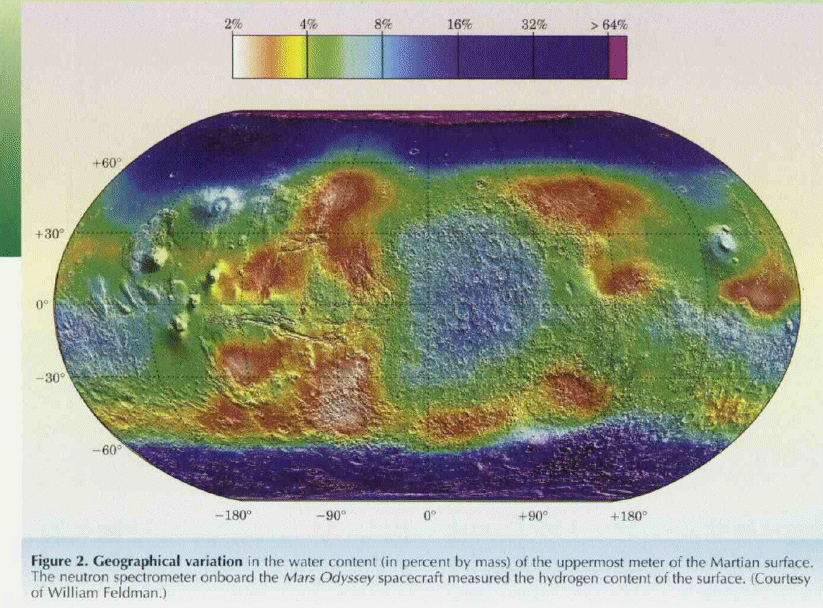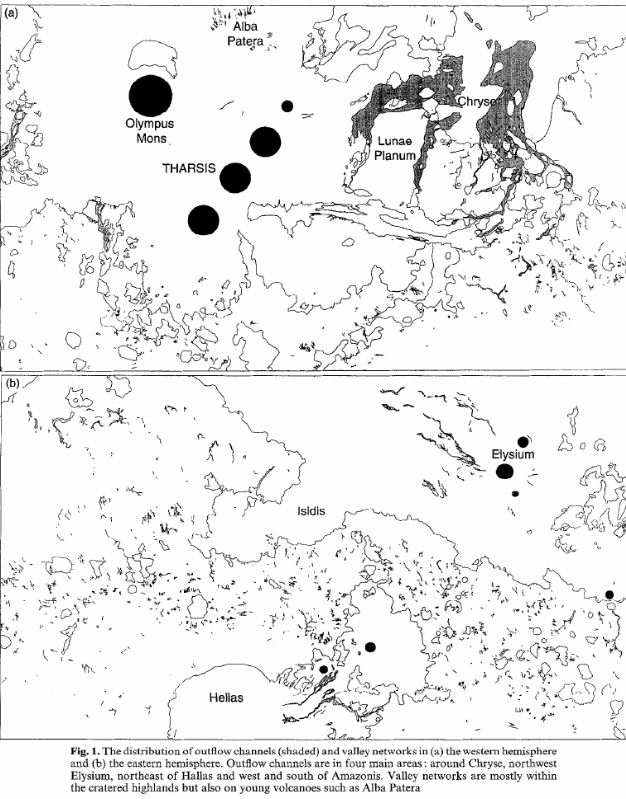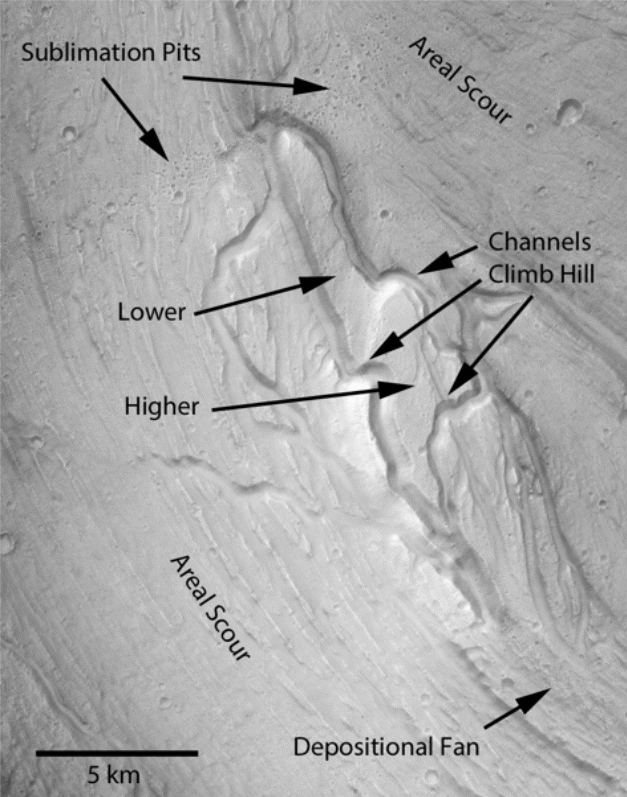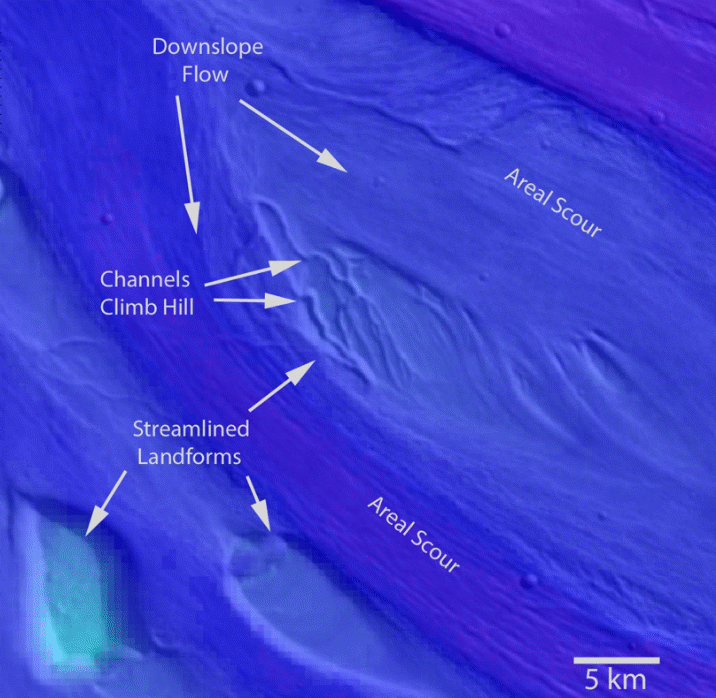According to McSween, scientists and astronomers find the study of the environment of Mars and the existence of flowing of water on the surface of the planet of special interest (1). McSween argues here that the evolution of any basic form of life depends on the existence of water. A deep water analogy of the existence of water in the atmosphere of Mars was based on the large scale polygonal terrains and other terrestrial elements on the surface of the planet, which makes Mars a viable candidate to study.
Mars, like the Earth, undergoes orbital oscillations which are caused by the behavior of the planet’s varying climatic conditions. Scientific evidence shows that the gravitational effects of other planets on Mars, particularly Jupiter, causes Mars to have an obliquity of 25.20 when compared with Earth’s obliquity of 23.50 (Clifford 1). Opponents of the existence of water in the atmosphere of Mars argue that the evidence that supports the existence of water in not scientifically conclusive.
Maheshwari argues that Mars’ gravitational force and its thin atmosphere cannot hold or retain water (3). It has been demonstrated that the weak strength of the gravity of Mars causes “subsurface porosity to a greater depth” to occur, supporting the argument that water cannot be found in the atmosphere of Mars (Clifford 6).
A further argument against the existence of water in the atmosphere of Mars is that the gullies and other geographical structures on the surface of the planet might have been caused by the movement of strong winds for millions of years. In addition, the average temperature on Mars is 60 K and ta that temperature liquid water cannot exist. Different authors further argue that the features observed on the surface of Mars were created by submarine terrestrial mass-transport deposits.
On the contrary, the presence of clay deposits, massive ridges, craters, and other subsurface characteristics support the positions that there might have existed large amounts of water in the atmosphere of Mars. Jakosky and Mellon refute the of the existence of water at one point in the history of Mars and assert that the Martian oscillations and the tilting of the planet towards the sun caused its polar ice caps to meltwater sublimates, which increased the global humidity during the early Noachian period (71).
Any slight changes in the obliquity of the planet dramatically changed the climate and the distribution of water-ice in the atmosphere. The presence of surface and sub-surface water-ice caused a significant amount of geomorphic changes to the environment, resulting in the type of climate variations depicted in the figure below (McSween 2).

The presence of ice-rich soils, variations in the climate, thermal stresses, and contractions led to the development of the features on the surface of Mars. That forms the basis of many years of scientific study and mapping of the surface of the planet, which has led to the conclusive evidence that liquid water, flowed in abundance on the surface of the planet (McSween 2).
Carr’s extensive discussions of scientific and unambiguous evidence of the flow of large amounts of water on the surface of the planet in the past were based on the geographic features and chemical compositions of the existing surface rocks (1). Carr’s report shows extensive channels consisting of polygonal features, small scale gullies, and valley networks on the surface of the planet, which was observed by a high-resolution spacecraft flying past Mars.
According to Carr, the observations include large terrestrial flood channels, cataracts, inner channels with diverging and converging score patterns, and plucked zones (2). The physical features shown below emphasize the existence of water 3.8 million years ago.

In a scientific conference held in 2014 to study additional evidence of the existence of water on the face of planet Mars millions of years ago, Arfstrom wrote about a network of channels observed on the surface of Mars as characteristic of the evidence of water (1).
Arfstrom’s channels are characterized by branching, and undulating elevated terminal deposition fans measuring 6 km wide and large scale streamlined landforms, as shown in the diagram below (3). Recent scientific findings of hematite, a substance associated with the presence of water, provide further evidence of a one-time presence of water in the atmosphere of Mars.

The two branches of streamlined landforms, which were the direct cause of erosion and selective large scale linear erosion consisting of sub-polar ice, converge at the end of the hill after a distance of 6 km. Observations and detailed investigations reveal striking features of sublimation pits presumed to be an icy mantle, which is assumed to have been caused by erosion (Clifford 2).
A clear illustration of the landscape caused by the flow of water is shown in the diagram below. After studying the evidence which shows the flow of water on the surface of the planet, the question arises on, where did the water go?

Where the water went
Conclusive evidence shows that millions of years ago, there was water on Mars. The assumption is based on geochemical evidence and a study of the oldest meteorites ALH84001 found on Mars. The meteorite is characterized by carbonates, which could have been deposited because of the presence of water 4 billion years ago.
A remote sensing study conducted by using MGS and Mars Odyssey to map the surface morphology of Mars shows further evidence of the effects of water. The question as to where the water went is still a mystery. The different hypothesis has been developed to answer the question of the disappearance of water from the planet Mars (McSween 2).
Today, there is no water in the atmosphere of Mars, and deep water levels that existed millions of years ago do not exist now. Scientific research has shown that water on the planet might have been lost because of the interactions between water molecules and solar winds, which broke the water molecules apart into hydrogen and oxygen molecules.
The molecules were later ionized and carried by the solar winds into the atmosphere (Stephen 2). Solar winds are plasma made of protons and electrons, which originate from the sun’s corona. Solar winds move radially from the sun at speeds of thousands of kilometers per hour (McSween 3).
When the wind enters the atmosphere of planets such as Mars with a low magnetic field, the solar wind interacts directly with any particles of the planet’s atmosphere setting up ionosphere currents, which deflect the planet’s magnetic fields around the planet. The resulting reactions between the neutral atoms and the solar winds cause drag in the speed of the solar wind, leading to the loss of the planet’s atmosphere (Maheshwari 1).
The ionized particles are then accelerated by the electric fields producing matter known as ENAs, which is composed of oxygen and hydrogen. Esther escapes from the atmosphere of the planet at high speeds. Here, the weak gravitational pull of the planet and the effects of solar winds are arguably the main causes of the loss of water into space (McSween 4).
The presence or absence of water could have significant scientific implications on scientific research, and the question that could be answered does the planet support life? One of the implications is that if water existed in the atmosphere of Mars, there could be the possibility of extraterrestrial life (Mcewen, 58).
It could show further that water exists in other planets and the possibility of different forms of life, other than the complex forms of life like on Earth, exist in those planets. It could be the beginning of the study of the evolution of life to understand how life forms evolve.
In conclusion, despite the overwhelming argument in favor of the fact that there is no water in Mars’ atmosphere which has never flowed on the surface, there is plenty of scientific evidence to show that water flowed on the surface of Mars millions of years ago.
The fundamental factors which caused the loss of water included weak gravitational strength coupled with the effects of solar winds. The crucial evidence is based on the surface landscape, the sublimation pits, ice at the Polar Regions, and other crucial features support the argument in favor of the presence of water in the atmosphere of Mars.
Works Cited
Arfstrom, John D. “A Possible Tunnel Valley Network in East Kasei Valles, Mars.” 45th Lunar and Planetary Science Conference. The Woodlands, Texas. 17-21 2014. Web.
Carr, Michael H. Water on Mars. New York: Oxford University Press,1996. Print.
Clifford, Stephen M. “A model for the hydrologic and climatic behavior of water on
Mars.” Journal of Geophysical Research: Planets 98. E6 (1993): 10973-11016. Print.
Jakosky, Bruce M., and Mellon, Michael T, “Water on Mars.” Physics Today 57.4
(2004): 71-76. Print.
Maheshwari, Raaz. “Water on Mars.” Bull. Env. Pharmacol. Life, Sci. 2.1 (2012): 01-02. Print.
Mcewen, Alfred S. “Mars in Motion.” Scientific American. 308.5 (2003): 58-65. Print.
McSween, Harry Y. “Water on Mars.” Elements 2.3 (2006): 135-137. Print.